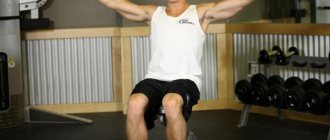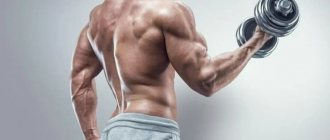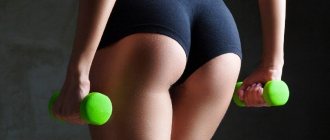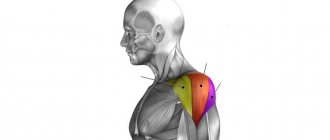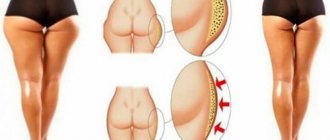≡ October 1, 2015 Category: Miscellaneous
The human body counteracts instability in the spine by forming bone spurs on the vertebrae, ossifying the ligaments, and overstraining the neck muscles. Over time, they freeze in this position and spasm, bending the spinal column, compressing the nerve roots and feeding vessels. Therapeutic gymnastics will help to avoid all these pathological changes. A set of exercises, when performed regularly and correctly, allows you to strengthen the muscle frame and better stabilize the shoulder girdle. Exercise therapy prevents the appearance of painful spasms in muscles, helps improve the metabolism of cartilage tissue of discs, and normalizes blood circulation in soft tissues. All this will help stop the development of osteochondrosis and stop the process of degeneration of intervertebral discs.
The best exercises for deltoids
Standing Dumbbell Press
Despite the fact that many are accustomed to performing this exercise while sitting, it is still better to perform it in a standing position. This way you can better develop the growth of your shoulder muscles. And although you'll be lifting less weight, the standing press requires more stability. This is why you are more likely to strengthen your entire body and add balance to it.
There is no doubt that the dumbbell bench press, performed with a full range of different muscle movements, is the best exercise for developing the deltoid muscle. A study conducted at the University of Padua showed that using a wide range of movements during the standing press caused the elbows to rotate 180 degrees and resulted in significant increases in the electromyogram (EMG) of the pectoral muscles, anterior deltoid, medial deltoid, posterior deltoid, upper trapezius, middle trapezius muscles, long head of triceps and teres minor.
Performing the exercise
If you didn't stretch your elbows enough while doing the shoulder press, you might be in for a surprise. Pick up the weight, use your full range of motion, and get results with these steps:
- Stand with your feet shoulder-width apart and hold dumbbells in both hands.
- Raise the dumbbells to eye level with your elbows bent at 90 degrees.
- Straightening your elbows 180 degrees, lift the dumbbells above your head.
- Pause and slowly return to the starting position.
Swing dumbbells to the rear delts in a lying position
Forget about exercise equipment. Recent studies have shown that EMG activity in the posterior deltoid and infraspinatus muscles was greater when performing a prone fly with a neutral hand position (palms facing each other) compared to a pronated grip (palms facing down). Although you will most likely want to perform this exercise on a machine, it is still better to use regular dumbbells and a bench. Free dumbbell weights will not only allow you to achieve optimal arm position, but will also help isolate the posterior heads of the deltoids and require more stabilization than machines.
Performing the exercise
- Lie face down on a flat bench. Toes should touch the floor. For convenience, you can place a folded towel under your forehead.
- Hold dumbbells in both hands and bend your elbows slightly.
- Start lifting the dumbbells, gradually bringing your shoulder blades together.
- Repeat. Maintain constant control and tension throughout each repetition.
Dumbbell swings or dumbbell flyes
This triset focuses primarily on the posterior deltoids, but also targets the medial and anterior deltoids. This exercise is great to end your workout. Remember that you should use light weights to maintain proper form and perform the exercise as efficiently as possible.
Performing the exercise
- Start in a bent position, with your core slightly tense and your knees bent.
- Perform the first seven reps with a neutral grip (palms facing each other). Bring your shoulder blades together, your back should be tense. Stay in this position for several seconds.
- Perform the next seven repetitions with a reverse grip (palms facing down).
- Do the last 7 reps with a neutral grip, lifting the dumbbells in front of you. Keep your shoulders down as you lift the dumbbells, then slowly lower them.
Raising arms to the sides with weights
Give a standard exercise a new twist. Using kettlebells will add additional stress to your arm and shoulder muscles, as you will have to exert even more control over each lift of your arm.
It's important to focus on squeezing the deltoids instead of letting impulse take over the movement.
Performing the exercise
- Hold the weights in both hands.
- Slowly extending your elbows, lift the weights until your arms are parallel to the floor. During the peak contraction phase, rotate your palms with your thumbs down for better muscle control.
- Pause for a couple of seconds and slowly return to the starting position.
Advanced version: Perform the exercise with heavier weights for more tension in the muscles.
Chest pull-up to the horizontal bar with a neutral grip
If you have never done this exercise, then you are missing out. This exercise will not only strengthen your deltoids and back muscles, but your entire body.
Performing the exercise
- Start with a neutral grip. Squeeze your shoulder blades together and pull yourself up until your chest touches the horizontal bar.
- The chest and shoulders should be open. At the peak of the contraction, focus on the rear deltoids. At your highest position, your body should be at a 45-degree angle to the floor.
- Slowly return to the starting position.
A set of exercises for hands[edit | edit code]
First level
- Knee push-ups
- Push-up
- Retraction of hands with the ball behind the head
- Army press
- Rotating around your head
- Clean up
- Overhead press
- Kettlebell Bench Press
- Medicine ball rotation
Advanced level
- T-turn push-up
- Retraction of hands behind the head with weights
- Shoulder press
- Diver
- Push press
- Ball push-ups
- Push-ups with simultaneous lifting of the torso and legs
- Passing the ball
- Underhand grip pull-up
- Overhand grip pull-up
Professional level
- Ball push-ups with alternating hands
- Side push-up with simultaneous lifting of the torso and legs
- Push-up from the bar
Shoulder structure and functions
Before you start training, it is important to understand which muscles you are going to strengthen and develop. Your shoulders are made up of the large deltoids—medial, posterior, and anterior—and the rotator cuff muscles, which support the ball-and-socket joint.
The rotator cuff muscles are made up of four muscles—teres minor, infraspinatus, supraspinatus, and subscapularis—that help rotate the shoulder.
The deltoid muscles are the main force that moves the arm. The anterior muscles are used when the arm rotates outward at the shoulder. The anterior deltoids also work with the subscapularis, pectoralis and latissimus dorsi to internally rotate the humerus so that the palms face down.
The posterior muscles are actively involved in lateral extension, such as when performing low pulley exercises. The longitudinal muscles help pull the shoulder back during full rotation, such as when raising the arms to the sides. They also perform the function of transverse rotation of the shoulder, as when performing the “reverse butterfly” exercise, when the shoulder turns outward
An important function of the deltoid muscles is also to support the humeral head to prevent dislocation when lifting heavy objects.
How to practice
When training the deltoid muscles, it is very important to pump all three bundles evenly. This will protect the Dynamic inferior stabilizers of the shoulder joint from injury.
The deltoid muscle bundles perform different functions, so it will not be possible to load them all with one exercise: you will have to include at least three movements in the training.
We have divided all the exercises into three parts: for pumping the front, middle and rear bundles. Choose one exercise from each category and add them to your workouts.
The weight is needed so that the last repetitions of the set are not easy, but without compromising technique.
Effective exercises for the muscles of the shoulder girdle
Pumped up shoulders and arms, beautiful chest, strong back and neck - every athlete dreams of this. Pumping up the upper shoulder girdle is always difficult. Physical activity to strengthen and develop the muscles of the upper body must be systematic and diligent.
It is important to use a comfortable weight and perform the movements with proper form.
You need to train a couple of times a week. There are exercises for the muscles of the shoulder girdle that are convenient to perform both in the gym and at home.
Training your shoulders, arms, back, chest and neck is necessary not only for those who set themselves the task of pumping up a sculpted body. These movements are effective for weight loss, because strength training allows you to burn extra calories and remove a few centimeters in volume.
Warm-up
To this end, you can do the following exercises:
- Shoulder rotation. You need to stand straight with your feet shoulder-width apart and keep your back straight. Keeping your head still, move your shoulder girdle first backwards and then forwards.
- Shoulder raises. They rise to their maximum height as you inhale, and then descend as you exhale. Stretching the shoulder girdle consists of a small number of exercises. Therefore, they are easy to remember.
- Swing your arms. Your arms should be straightened at the elbows. First they are rotated forward, and then backward. Proceed at high speed to give your shoulder muscles a good workout.
Men's training program
To pump up the upper shoulder girdle, you need to use the muscles of the deltas, neck, chest, trapezius, forearms and even the abs during training. Tension and relaxation of muscles perfectly trains and strengthens muscle fiber bundles.
The following effective and time-tested movements should be included in your upper-girdle program:
Arnold press
Iron Arnie himself loves this technique. The technique is simple. You need to take dumbbells, bend your arms at the elbow joints so that the equipment is next to your neck. The palms are turned towards you, and the thumbs look outward. Inhale and smoothly raise your arms up
When the equipment is parallel to the top of the head, you should carefully unfold your palms. We continue to straighten our arms, fix the top point for 1-2 seconds, and return to the position from which we started the movement.
Raising your arms forward
To perform this, you need to stand straight, take dumbbells in your hands, and turn your palms towards you. We inhale and raise our extended limbs forward. The maximum point is just above the shoulder line. It is important not to change the distance between the dumbbells. An accessible option is to raise your hands one at a time.
Raising arms to the sides
The exercise perfectly works the trapezius and deltoids. Starting position – stand straight, legs apart at shoulder level, weights in hands, limbs relaxed along the body. After inhaling, raise your arms to the sides, creating a slight angle at the elbow. You need to lift until your hands are in the same plane as your shoulders. We stop for a couple of seconds and lower our hands. We don’t take a break, but repeat the movement.
Dumbbell raises at an angle
The exercise is suitable for performing in the gym. This is where the back of the deltoids work. You need to sit on a sports bench, adjusting the comfortable angle. We stretch our arms with dumbbells straight in front of us. We inhale and as we exhale we spread our limbs to the sides, do not bend the elbow, we work with the shoulder joints. You should not throw your arms at the extreme point; it is important to constantly maintain tension.
Pull-ups in different variations
For the arms, chest and back, pull-ups on the horizontal bar are always indispensable. To give different muscle groups a workout, change your grip width.
Extensions while lying on a bench with weights
This exercise is very beneficial for the neck. You should lie on a horizontal bench, place a weight plate on the back of your neck, holding it with your hands. Slowly you need to bend and straighten your neck, gradually increasing the amplitude.
If you are training with dumbbells or a barbell, initially use the minimum weight. The load should be increased gradually as the body adapts. Don't train every day, give your muscle fibers time to recover.
Secrets of women's training
During training, women do not set a goal to build muscle mass; on the contrary, it is important for them to lose weight and emphasize the beauty of their body
This is why it is important not to focus on weight during exercise, but focus on repetition frequency. The optimal weight of dumbbells is 1.5-4 kg.
Before starting the lesson, be sure to swing your arms, rotate your shoulders, bend and straighten your elbows several times, and stretch your hands. If a girl pumps up her upper shoulder girdle, it will be much easier for her to cope with the load during training on other muscle groups, and her body will become much more resilient and stronger.
You can also exercise with an expander to develop the muscles of the upper shoulder girdle. This type of sports equipment is as easy to use as possible. It is often used in training for children.
Don't forget to eat right and stay hydrated. Walk more in the fresh air, play active and outdoor games, systematically train in the gym or at home, and the result will not take long to arrive - the muscles of the upper shoulder girdle will become beautiful, rounded and sculpted.
Read also[edit | edit code]
- Forearms - exercises and training
- Shoulders - exercises and training features
- Biceps - exercises and training features
- Triceps - exercises and training features
- Specialized training, hands
- Arm training program
- An effective program for pumping up your arms
- Arm exercises (for women)
- Training program with an emphasis on arms
- How to pump up arm muscles
- How to pump up your shoulders (deltoids)
- Shoulder training in the gym
How to do exercises correctly
In the initial stages of the disease, a person can choose exactly those exercises that suit him. If the patient has severe disorders of the spinal column, then a complex of exercise therapy must be prescribed by a doctor. The beginning of any workout always begins with lighter exercises that affect the entire body. Their task is to warm up the muscles and prepare them for the main loads. This will help prevent injury and increase the positive effect of training.
Warm-up movements include:
- Walking alternating on the outer and inner parts of the foot, lasting up to 3 minutes.
- Tension and relaxation of the arms when positioned along the body, number of repetitions 10-15 times.
- Circular movement of the shoulder in the joint. This warm-up will help increase blood flow to the glenohumeral region and improve the condition of the shoulder joint.
The main part of the complex consists of a number of simple exercises. Thus, the following are the most effective exercises, which must be repeated at least 5 times:
It is better to coordinate exercise therapy on shoulders with osteochondrosis with your doctor.
- Protrusion of the head forward, while counteracting yourself with a hand attached to the forehead.
- Take turns trying to touch your ear to your shoulder without lifting it. In this case, the scapular section of the muscular frame is stretched.
- Pressing the chin to the jugular fossa.
- Turns the head with the lower jaw lowered.
- Drawing a wide circle with the chin. This will improve blood flow to the glenohumeral area.
- In a position where the head is level and turned to the side, describe the letter “M” with your chin, moving in the opposite direction.
- An effective exercise with a stick, which is thrown behind the neck and, holding it with your hands, aligns the shoulders.
- Touching the chin to the shoulder, while the head is positioned straight.
By allocating 15-20 minutes a day to perform simple exercises, you can forget about the presence of osteochondrosis of the cervical-brachial region forever. This is especially true for people whose profession involves prolonged sitting, as well as those who lead a sedentary lifestyle. And if you combine exercises with light self-massage, the benefits for the neck will increase significantly.
Post-workout stretching
When you finish doing exercises aimed at developing the shoulder girdle, be sure to take a few minutes to stretch. You need to proceed as follows:
- Raise one arm and extend it in front of your chest, and then bring it to the opposite shoulder. Help yourself with your other hand - you should feel a stretch. But don't lift your shoulder. Start warming up your shoulder girdle with this exercise.
- Interlace your hands. The right elbow should be above the inner fold of the left. In this case, the fingers of the left hand should tightly clasp the wrist of the right.
- Clasp your hands behind your back and stretch thoroughly.
- Place one hand against the wall, place the other on top of it and press down slightly. Rotate your shoulder, releasing tension, and at the same time turn your back to the wall. Repeat for the second hand.
Be careful when stretching. It is important that you do not feel pain - otherwise you could damage your muscles. The functions of the shoulder girdle are very simple and equally important. Give this muscle group the attention it deserves and you will look great!
Therapeutic gymnastics for the shoulder joint Evdokimennko
There is also gymnastics developed by resuscitator P.V. Evdokimenko, who is the author of a large number of books on joint health. His approach demonstrates effectiveness, which is why it is popular. The author of the technique insists that the main attention should be paid to the individual characteristics of the patient. There is both a simplified version of the gymnast (if the patient has limited movements) and a standard one.
Most exercises are performed in a sitting position, and only two are done standing. Typically the following exercises are recommended for the shoulder joint:
- While sitting on a chair, place your hands on your waist and relax. Then perform smooth circular movements back and forth with both shoulders - 1.5 minutes in each direction.
- Same starting position, relax your shoulders as much as possible. Pull them back, tensing your muscles, and then bring them together. Repeat the action 5-7 times.
- While sitting on a flat surface, place the palm of your healthy hand on the opposite elbow and place the other palm on the other shoulder. Relax as much as possible, very carefully pull the sore limb up, holding it by the elbow, which does not leave the shoulder. This action is aimed at achieving maximum abduction of the shoulder, when the muscles are sufficiently tense, but there is no pain. Fix your shoulder in this position for 10-15 seconds, then smoothly return to the starting position. Repeat the complex at least five times.
- In a lying position, move your arm to the side, slightly lifting it above the surface, and tense it for 5-10 seconds, then relax. The palm should be as open as possible, and the shoulder should be on the edge of the surface.
Treatment of the shoulder joint with exercises
Exercises for pain in the shoulder joint can be performed independently, together with an instructor. They will be useful not only if a person suffers from pain and limited joint mobility, but also for the prevention of such problems. They promote effective stretching and warming up of muscles.
At first, it is recommended to perform the exercises together with a doctor, but in the future you can do them at home on your own.
Therapeutic exercises for the shoulder joint are usually performed in an upright position. Every day you need to do the following exercises 10 times:
- Both hands need to be raised with their palms facing each other. Then stretch your fingers well, turn your palms forward and alternately stretch your arms, lifting your shoulders. Do the exercises for 3-5 minutes depending on how you feel. Having completed the pull-ups, smoothly proceed to further actions.
- Spread your arms to the sides, then turn to the left, stretch the fingers of your right hand, turn your head slightly and look up. Then do the same for the other side. This exercise helps restore normal movements of the cervical-brachial region. It must be performed at least ten times.
- Keep your arms parallel to a flat surface, bend your palms slightly towards you and make a circular motion with your arms, engaging the shoulder girdle. Do 5 reps forward and backward.
- The arms remain in the same position, but you need to move them back a little and lower them so that the hands are located below the shoulders. Slowly clench and unclench your fists, open your palm as much as possible and extend your fingers. This exercise is useful for a diagnosis such as shoulder osteochondrosis.
- Spread your arms slightly to the sides, clench your fist and rotate your hand back and forth five times.
- Raise your arms and bend them at the elbow joint. With the palm of your right hand, clasp your left elbow, and then vice versa. The shoulders are alternately pulled up so that you feel the stretching and warming up of the muscles.
During the last exercise, do not bend at the lower back.
The gymnastic complex must be performed every day - only then will you get stable results and be able to improve your condition.
We recommend that you read: exercises for the elbow joint after a fracture
Triset on the lower block
Do all the exercises in this set first with one hand, then with the other. Those. first exercise: 8-16 repetitions with the right hand, after 8-16 repetitions with the left hand. Move on to the second exercise. And so on.
The exercises can be done in any order. But the first and third are done with the back tilted, so it’s better to do standing biceps curls between them to give your back a rest.
A1 Abduction of the arm to the side (as during a lying dumbbell fly)
A2 Biceps Curl
A3 Triceps extension
Exercise 3: Dumbbell Bench Press
Necessary equipment: dumbbell/filled container (2 pcs.) Starting position: lying on your back, arms with the weight lowered along the body, legs bent at the knees. Technique: while inhaling, simultaneously raise your arms straight and hold them for a few seconds; while exhaling, bend your elbows and lower them to the floor. Inhale - slowly raise your arms up, exhale - return them to their original position. It is recommended to perform the exercise in 2-3 sets of 10-15 times.
It is permissible to increase the load by performing the exercise with your knees bent.
